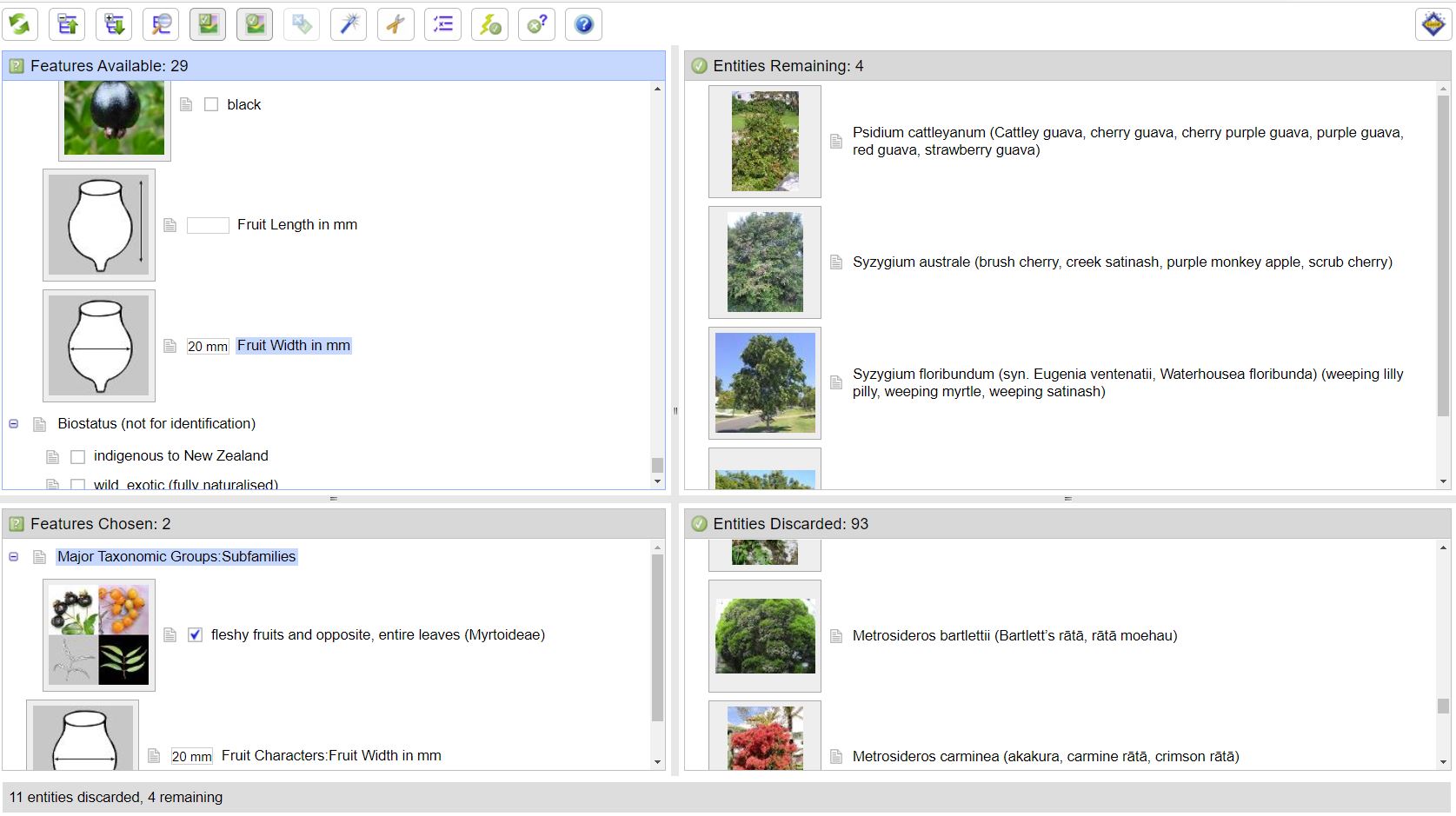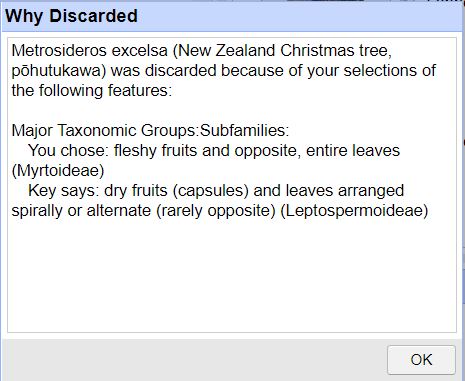Running the Lucid key through your web browser requires no additional software or plug-ins. Lucid multi-access keys are simple to use once some basic functions are understood. The process involves working through each group of features and selecting the features that match your specimen in order to narrow the options down to just one, or a few, remaining taxa. You can select features in any order you choose, which means you can still make progress towards identifying the plant if any features are missing from your specimen.
How to use the NZ Myrtaceae Key
Introduction
Lucid online player tips
The Lucid online player screen has a menu bar (Restart | Collapse Tree | Expand Tree | Find | Sets | Best | Prune Redundants | Differences | Why Discarded | Help) at the top and four windows (Features Available, Features Chosen, Entities Remaining, Entities Discarded) below.
Features are comprised of characters (e.g. flower colour) and character states (e.g. flowers red). Entities in this key are typically species, but also subspecies, varieties, hybrids, and cultivars (collectively called taxa).
On start up only the Features Available and Entities Remaining windows will have content. As features are selected (using the tick boxes) they will appear in the Features Chosen window, and the entities that don’t possess those features will be discarded (Entities Discarded).
There are
![]() notes and
notes and ![]() images attached to all features and entities.
Click on the icons (or thumbnails) to open them.
images attached to all features and entities.
Click on the icons (or thumbnails) to open them.

![]() Restart – restarts the key to
the default Features Available list (you may need to refresh after restarting if the
features don’t appear).
Restart – restarts the key to
the default Features Available list (you may need to refresh after restarting if the
features don’t appear).
![]() Collapse Tree – collapses the
features
tree hierarchy to hide the character states. You must first click on the Features panel to select it
so that this function will work. You can also collapse the entities hierarchy if they
are in a tree.
Clicking the Collapse Tree menu button collapses/closes all features (characters and character states), not just the one selected.
Collapse Tree – collapses the
features
tree hierarchy to hide the character states. You must first click on the Features panel to select it
so that this function will work. You can also collapse the entities hierarchy if they
are in a tree.
Clicking the Collapse Tree menu button collapses/closes all features (characters and character states), not just the one selected.
![]() Expand Tree – expands the
features to show the
submenus and character states. You must first click on the Features panel to select it so
that this function will work. You can also expand the entities hierarchy if they were in a tree.
Clicking the Expand Tree menu button expands/opens all features and states, not just the one selected.
Expand Tree – expands the
features to show the
submenus and character states. You must first click on the Features panel to select it so
that this function will work. You can also expand the entities hierarchy if they were in a tree.
Clicking the Expand Tree menu button expands/opens all features and states, not just the one selected.
![]() Find – find
feature, character state or entity, depending on which panel you have selected and
what text you have entered in the search box.
Find – find
feature, character state or entity, depending on which panel you have selected and
what text you have entered in the search box.
![]() Sets – selects
feature/entity sets (greyed out if no sets
are assigned in the key).
Sets – selects
feature/entity sets (greyed out if no sets
are assigned in the key).
![]() Best – once you’ve keyed out
(selected) some features and want to know where to go next, you can use Best.
This selects the next best feature to help reduce your Entities Remaining list. If the
feature suggested by Best is not suitable, you can continue to click Best to move to the next-best feature until you find a feature you can answer.
Best – once you’ve keyed out
(selected) some features and want to know where to go next, you can use Best.
This selects the next best feature to help reduce your Entities Remaining list. If the
feature suggested by Best is not suitable, you can continue to click Best to move to the next-best feature until you find a feature you can answer.
![]() Prune Redundants – removes features and/or states that are no longer relevant, based on the species in the Entities Remaining list.
Prune Redundants – removes features and/or states that are no longer relevant, based on the species in the Entities Remaining list.
![]() Differences – if you want to know the differences
among the Entities Remaining, click
Differences. This will calculate what features are different by showing a
pop-up window separated into two lists: Features and Differences. Select a
feature from the top drop-down menu to show how the states are different from
the list of remaining entities.
Differences – if you want to know the differences
among the Entities Remaining, click
Differences. This will calculate what features are different by showing a
pop-up window separated into two lists: Features and Differences. Select a
feature from the top drop-down menu to show how the states are different from
the list of remaining entities.

![]() Why Discarded – if you want to know why an
entity was discarded, select an entity from the Entities Discarded panel and click Why Discarded.
This will open a pop-up window showing what feature(s) (character states) you selected and what that
entity is coded for.
Why Discarded – if you want to know why an
entity was discarded, select an entity from the Entities Discarded panel and click Why Discarded.
This will open a pop-up window showing what feature(s) (character states) you selected and what that
entity is coded for.
System requirements for the Lucid online player
Operating System: any operating system that supports a modern web browser and JavaScript (e.g. Windows, Mac OSX, Linux, Solaris). Note: native apps for the NZ Myrtaceae Key are available for both Android and iOS. These dedicated (non-browser) apps are best for those operating systems because the identification key and content have been optimised for those environments and screen sizes.
Browser requirements
It is recommended that you run the key using a modern web browser (e.g. Chrome,
Edge, Firefox, Opera, Safari) that supports JavaScript.
Please note: due to the interactive nature of the content, some browsers and pop-up blockers may prevent the fact sheets from loading. If you experience this, please set your browser or pop-up blocker to allow this content.
If you want to learn more about the Myrtaceae family and the identification process, see:
- Learn about Myrtaceae, which includes an overview of the importance and features of the family, the scope of the key, and threats posed by myrtle rust
- About the NZ Myrtaceae Key, which includes why the key was created, further reading and references
- Lucid Help, for more detailed notes on how Lucid works.
Some tips to remember when using Lucid
- Become familiar with the specimen you wish to identify.
- Note any features (characteristics) you think might be relevant.
- Choose an appropriate character set (e.g. the Flower Characters set if your specimen is in flower).
- Browse the characters list and answer any easy character first. This is an advantage of a multi-access interactive key compared to a dichotomous key which has a single start point and a pathway of only two choices each time.
- When selecting character states, always choose more than one if you are uncertain. This will retain the taxa that are coded for either state and not those coded for both.
- If you are using a measurement character, where possible take an average measurement rather than the largest or smallest.
- When you’ve addressed all the obvious characters, ask the player to suggest the best remaining character.
- If you have no taxa left, review what you have chosen and deselect any character states you are doubtful about.
- Don’t assume you will end up with a single taxon remaining. In many cases there may be a small number of taxa remaining. These can usually be differentiated by checking the images and fact sheets.
- Once you have a potential answer, check the corresponding fact sheet to see if the information matches.
Some tips to remember when using the NZ Myrtaceae Key
- If the character you’re using is not obvious, check the notes for any specific instructions. Remember that some characters are not always obvious and they can depend on people’s perceptions. While every effort has been made to include all possible interpretations some will be missed, which can make some characters less powerful. Colour and shape characters are obvious examples. Please remember to look at the images available for the character states: these may help to avoid misinterpretation, as coding has been done with these images in mind.
- If you are identifying plant material that has been grown in a glasshouse or in some other simulated environment, remember that these plants are growing under optimal conditions and that some of the plants’ characteristics may be at the extremes of their naturally occurring habit. Features such as flowering time and leaf size can be affected by optimal growing conditions. This should be kept in mind when using these types of characters to identify your specimen.
Identifying eucalypts
If you are having trouble identifying a eucalypt (Angophora, Corymbia, or Eucalyptus) to species level using this New Zealand Myrtaceae Key, we recommend you try the dedicated Australian EUCLID key, available online at https://apps.lucidcentral.org/euclid/text/intro/index.html and as smartphone/tablet apps from Google Play (Android) and Apple’s App Store (iOS).

